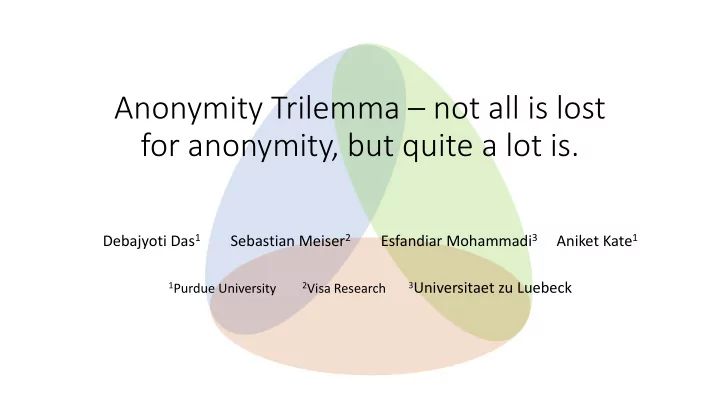

Anonymity Trilemma – not all is lost for anonymity, but quite a lot is. Debajyoti Das 1 Sebastian Meiser 2 Esfandiar Mohammadi 3 Aniket Kate 1 1 Purdue University 2 Visa Research 3 Universitaet zu Luebeck
Anonymous Communication (AC) Networks Alice Bob Sender Anonymity 2
Example AC protocol : Mixnets 3 Bob 1 2 Alice Mixnets can provide anonymity at the cost of high latency overhead. Anonymity can also be achieved at the cost of high bandwidth overhead. 3
Anonymity Trilemma good anonymity • Q1: Can we achieve good anonymity without introducing large latency or bandwidth overhead? - NO. low bandwidth low latency overhead overhead IEEE S&P 2018 4
Sender Anonymity (AnoA definition) Alice Eve Pr[ Eve:“Alice”| Alice sends message] Bob ≤ Pr[ Eve:“Alice”| Bob sends message] + δ ( η ) strong: δ ( η) ≤ negl( η ) 5
Bandwidth Overhead and Latency Overhead • We consider one communication round as one time unit. • Latency overhead l is the number of rounds a message can be delayed by the protocol before being delivered. S R Latency overhead l = 4 Bandwidth overhead β = 2/4, B = 2 • Bandwidth overhead β is the number of noise messages per user per round, i.e., the dummy message rate. • The number of noise messages per real message is denoted with B. 6
Prior Results for mix-nets (including onion routing) • When users send messages at bandwidth β a rate of p’ per user per round, To achieve strong anonymity against δ = negl( η ) a global passive adversary: 2 l (β+p ’ ) ≥ 1 2 l (β+p ’ ) = 1 latency l 7
When Adversary can compromise c protocol parties bandwidth β • to achieve strong anonymity against 2( l −c)(β+p ’ )≥ 1 a passively compromising adversary: when c>0 l > θ(1) - 2 l (β+p ’ ) = 1 2( l −c)(β+p ’ )≥ 1, when l > c . - l in θ(1) latency l 8
Is it impossible to achieve strong anonymity with constant latency overhead, when c>0 ? - NO. - Example: DC-net with user coordination . The protocol model in the previous work did not assume any out-of-band user coordination. 9
DC-net type protocols – user coordination (UC) • Alice wants to send message m. Charlie • Bob and Charlie send packets to help Alice. • Those 3 packets are shares of message m. Bob Eve • We assume that this coordination can be Alice achieved via a pre-setup, and hence, Eve can retrieves the actual the cost of UC to be 0. message only after combining all three packets. Issue: these protocols use very high bandwidth overhead. The overhead (number of dummy messages) per real message, B > (N-1), N = total users. 10
Protocols beyond mix-nets – protocols with UC Debo Charlie 3 2 Eve 1 Bob Eve retrieves the message from Alice only after combining all three packets. Alice Bob and Charlie send shares for Alice’s message, with some pre-setup, without Alice communicating to them. 11
Assumptions on protocols with UC Charlie Eve1 3 1 Bob Eve2 2 Alice Assumption 1: One of the packets is sent by the actual sender Alice. 12
Assumptions on protocols with UC Charlie Eve1 3 1 Bob Eve2 2 Alice Assumption 2: One packet does not take part in the reconstruction of two separate messages. 13
Assumptions on protocols with UC Eve 3 1 Bob 2 Alice Assumption 3: Mixing is not possible at a compromised node. 14
Results are same when no parties are compromised bandwidth β • To achieve strong anonymity against δ = negl( η ) a global passive adversary: 2 l (β+p ’ ) ≥ 1 2 l (β+p ’ ) = 1 latency l The universal necessary constraint still holds, except l =0. 15
Quantum of Solace: when protocol parties are compromised 2( l −c)β ≥ 1 when c>0 • If strong anonymity is not required, user coordination could allow better anonymity. • Better resistance against compromization. 2 l (β+p ’ ) = 1 latency l 16
Effect of coordination: resistance against compromised protocol parties – some cases • Case 1: K/c = const. where K is the total number of nodes. The impossibility condition for anonymity: - without User Coordination l ϵ O(log( η )) - with User Coordination l 2 ϵ O(log( η )) • Case 2: AnyTrust Systems: K-c = const. , l β=1 , l <c< l 2 : - it is impossible to achieve strong anonymity for protocols without User Coordination - protocols with user coordination escapes that impossibility. 17
Takeaways bandwidth β • Our work points protocol designers to focus on protocols with user coordination, to at least achieve resistance against compromization. • Still we can not do better than the limit specified by the universal necessary constraint: 2 l (β+p ’ ) ≥ 1. 2 l (β+p ’ ) = 1 when c>0 • Unless we break one of the assumptions on user coordination. latency l 18
A New Hope: Challenge 1: Achieve mixing at a dishonest node. X Still strong anonymity will be impossible for 2 l (β+p ’ ) < 1 19
The Rise of User Coordination: Challenge 2: Break Assumption 2. - Generate n shares for m messages in a privacy preserving way with low communication overhead and low latency overhead. Charlie Eve1 3 1 Bob Eve2 Alice 20
https://freedom.cs.purdue.edu/projects/trilemma.html Thank you. ☺ @tutaidas das48@purdue.edu 21
Recommend
More recommend